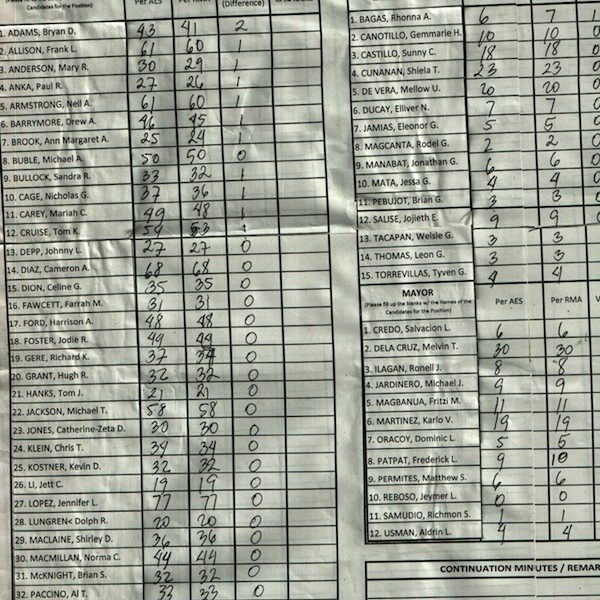By MIKHA FLORES
THE discrepancies between the machine count and the random manual audit (RMA) in the mock elections held Saturday at the University of the Philippines Integrated School (UPIS) exceeded the threshold set by the Commission on Elections.
Elections Commissioner Christian Robert Lim said 15 mismatches—13 in the senatorial candidates—were listed in the tally of votes between the election returns (ER) of the Precinct Count Optical Scan (PCOS) machines and the RMA. The count in the congressman and mayor had one discrepancy each.
Comelec set the threshold at 10 discrepancies.
“Pag umabot ng 10 or more, our protocol is you bring the ballot box back to the main office, examine namin ulit at tingnan namin kung ano yung problema (If it reaches 10 or more, our protocol is to bring the ballot box back to the main office, reexamine it and identify the problems),” Lim, who is in charge of the RMA, said Saturday.
The random manual audit team (RMAT) counted 158 ballots and one diagnostic ballot. Voter turnout was 21 percent. UPIS is one of the 10 areas chosen by Comelec for the nationwide mock elections in preparation for the May 13 polls (See map).
“In five days, we’ll have to validate with the National Statistics Office (NSO) everything and we’ll try to explain why there is a difference,” Lim said.
Republic Act 9369, the law that governs automated elections, requires an RMA in one precinct in every congressional district. The RMA determines whether the machine counts tallied the right vote for a candidate. It will also initiate a manual count for precincts affected by discrepancies between the PCOS count and the RMA count.
“There will be discrepancies. What we’re trying to do with the RMAT for 2013 is we’re trying to close that gap,” Lim said.
Lim said the difference between the appreciation of machines and humans in the level of shading is one reason for the discrepancy.
“Minsan depende sa shade. Minsan mahina ang shade na hindi binasa sa machine but kung sa human eye, pwede na to, bibilangin yan (Sometimes it depends on the shade. Sometimes the shade was below the threshold, but the human eye would still accept it),” Lim said.
The recurrence of “undervotes” and “overvotes” in the senatorial race was cited as another factor.
Lim said it was a “new variable in the equation” since the Comelec based the threshold on the 2010 Presidential Elections.
The auditing team listed 250 undervotes and six overvotes in the tally. Undervotes occur when a voter’s shade is below the 12 slots for senators while overvotes happen when a voter exceeds the shading for an elective post.
“Pwedeng mag-increase or pwedeng mas maghigpit lalo sa senators na pano dapat yung appreciation, (We can increase the threshold or provide stricter rules in ballot appreciation),”Lim said when asked what they intend to do to address the issue.
Apart from the slow pace of the audit, Lim lauded the team for their work.
“Sobrang professional ng RMA team (The RMA team is very professional). They’re really concerned about finishing their job,” Lim said.
The team is composed of teachers from Ponciano Bernardo High School in Quezon City.
The audit took almost four hours. The team started at around 9:30 p.m. and ended at around 1:30 after midnight.
RMA Committee Ambassador Henrietta Chair De Villa vowed to have a “better” manual audit than the ones in 2010.
“(In 2010), we did not have the RMAT doing validation on their level. Lahat ng may problema inakyat sa national kaya it took so long (All problems were referred at the national level. That’s why it took so long),” De Villa said.
Members of the 2013 RMA Committee (RMAC) for the May 13 elections include De Villa, chairperson of the Parish Pastoral Council for Responsible Voting, Agnes Carreon of Comelec’s Internal Audit Office, and Carmelita Ericta, NSO Administrator. A five-member secretariat will assist the RMAC in the auditing.
The RMA team for the 234 legislative districts will be finalized by the end of the month. By March or April, the team would have been trained already to perform the audit, De Villa said.
“Before, we did not have that luxury because the timeline was so short. We didn’t know what it was about. We were still creating the scenarios and the general instructions. We were coming in from blank before,” she said.
The PPCRV chairperson added the team expects to finish the report of the audit by the end of May or the first week of June.




